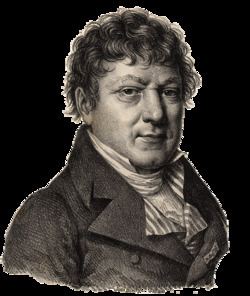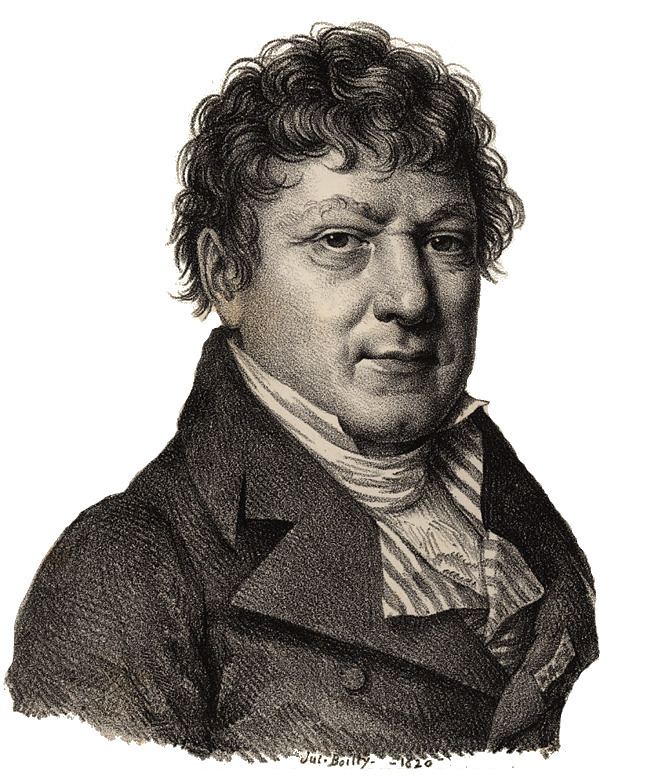Nationality French Education University of Paris Doctoral advisor Jerome Lalande | Name Jean Joseph Doctoral students Gerrit Moll Role Mathematician Academic advisor Jerome Lalande | |
 | ||
Born 19 September 1749Amiens ( 1749-09-19 ) Died August 19, 1822, Paris, France Books Histoire de L'astronomie Moderne | ||
Jean Baptiste Joseph, chevalier Delambre (19 September 1749 – 19 August 1822) was a French mathematician and astronomer. He was also director of the Paris Observatory, and author of well-known books on the history of astronomy from ancient times to the 18th century.
Contents

Biography
After a childhood fever, he suffered from very sensitive eyes, and believed that he would soon go blind. For fear of losing his ability to read, he devoured any book available and trained his memory. He thus immersed himself in Greek and Latin literature, acquired the ability to recall entire pages verbatim weeks after reading them, became fluent in Italian, English and German and even published Règles et méthodes faciles pour apprendre la langue anglaise (Easy rules and methods for learning English).
Delambre's quickly achieved success in his career in astronomy, such that in 1788, he was elected a foreign member of the Royal Swedish Academy of Sciences. In 1790, to establish a universally accepted foundation for the definition of measures, the National Constituent Assembly asked the French Academy of Sciences to introduce a new unit of measurement. The academics decided on the metre, defined as 1 / 10,000,000 of the distance from the North Pole to the equator, and prepared to organise an expedition to measure the length of the meridian arc between Dunkirk and Barcelona. This portion of the meridian, which also passes through Paris, was to serve as the basis for the length of the quarter meridian, connecting the North Pole with the Equator. In April 1791, the academy's Metric Commission confided this mission to Jean-Dominique de Cassini, Adrien-Marie Legendre and Pierre Méchain. Cassini was chosen to head the northern expedition but, as a royalist, he refused to serve under the revolutionary government after the arrest of King Louis XVI on his Flight to Varennes. On 15 February 1792, Delambre was elected unanimously a member of the French Academy of Sciences and in May 1792, after Cassini's final refusal, was placed in charge of the northern expedition, measuring the meridian from Dunkirk to Rodez in the south of France. Pierre Méchain headed the southern expedition, measuring from Barcelona to Rodez. The measurements were finished in 1798. The gathered data were presented to an international conference of savants in Paris the following year.
In 1801, First Consul Napoléon Bonaparte took the presidency of the French Academy of Sciences and appointed Delambre its Permanent Secretary for the Mathematical Sciences, a post he held until his death.
After Méchain's death in 1804, he was appointed director of the Paris Observatory. He was also professor of Astronomy at the Collège de France. The same year he married Elisabeth-Aglaée Leblanc de Pommard, a widow with whom he had lived already for a long time. Her son, Achille-César-Charles de Pommard (1781–1807) assisted Delambre on several occasions in his astronomical and geodetical surveys, notably the measuring of the baselines for the meridian survey, and the latitude definition for Paris in December 1799 which was presented to the Conference of Savants.
Delambre was one of the first astronomers to derive astronomical equations from analytical formulas, was the author of Delambre's Analogies and, after the age of 70, also the author of works on the history of astronomy like the Histoire de l'astronomie. He was a knight (chevalier) of the Order of Saint Michael and of the Légion d'honneur. His name is also one of the 72 names inscribed on the Eiffel tower. He was elected a Foreign Honorary Member of the American Academy of Arts and Sciences in 1822.
Delambre died in 1822 and was interred in Père Lachaise Cemetery in Paris. The crater Delambre on the Moon is named after him.
Delambre was an atheist.
Works
Reprinted by New York and London: Johnson Reprint Corporation, 1965 (Sources of Science, #23), with a new preface by Otto Neugebauer. OCLC 648488.
Text on line: vol. 1, [1], [2], [3]; vol. 2, [4], [5].
Reprinted by New York and London: Johnson Reprint Corporation, 1965 (Sources of Science, #24.) OCLC 647834.
Also reprinted by Paris: J. Gabay, 2006. OCLC 494627038.
Text on line: [6].
Reprinted by New York and London: Johnson Reprint Corporation, 1969 (Sources of Science, #25), with a new introduction and tables of contents by I. Bernard Cohen. OCLC 647838.
Also reprinted by Paris: Editions Jacques Gabay, 2006. OCLC 493779358.
This takes the history to the 17th century.
Text on line: both volumes, with usable plates, [7]; vol. 1, [8], [9], [10]; vol. 2, [11].
Reprinted by Paris: J. Gabay, 2004. OCLC 470502171.
This includes the history of astronomy in the 18th century, especially critiques of his colleagues at the Academy, which he withheld to be published posthumously.
Text on line: [12]; with usable plates, [13].
